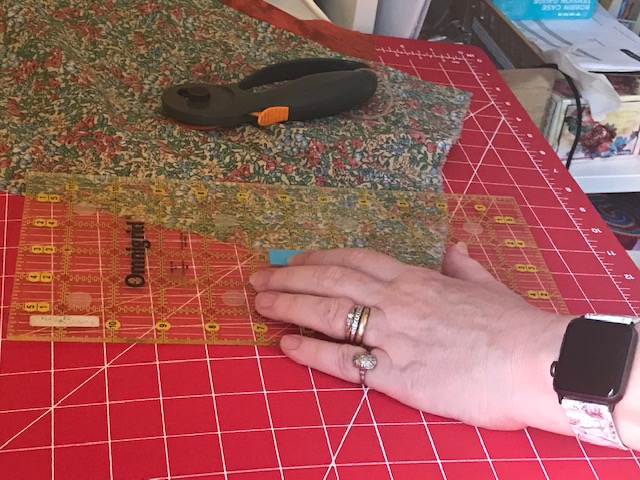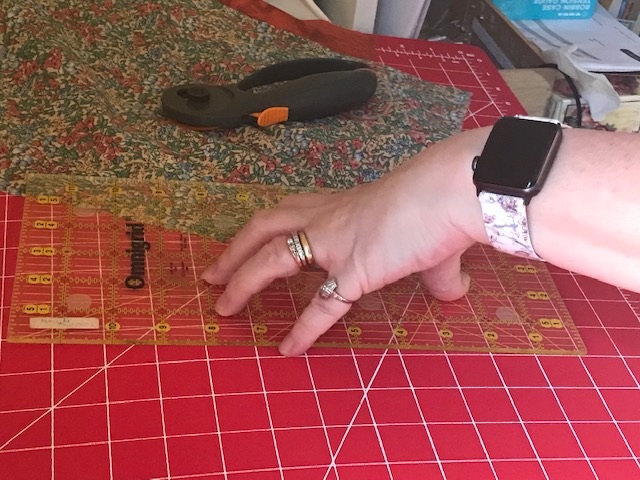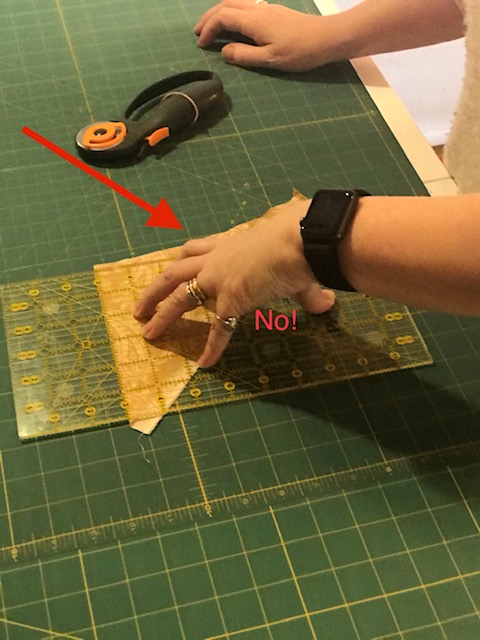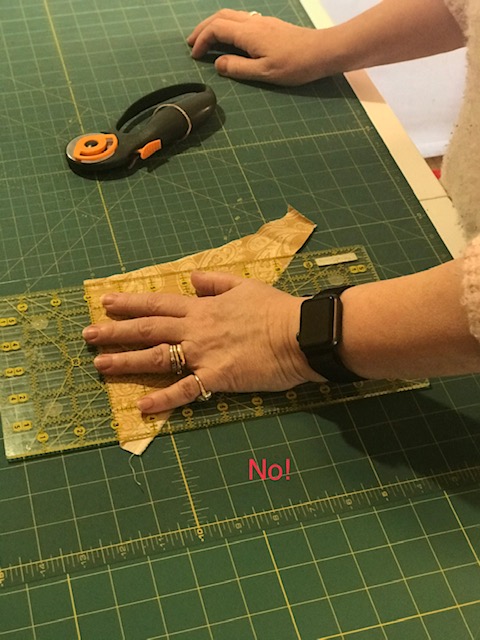Rotary cutters are amazing for helping speed up the fabric cutting process and for accuracy. I know I definitely cannot cut a long 2.5 inch strip with scissors, no matter how well I mark. But rotary cutters are not without drawbacks, one being it’s very easy to hurt yourself and it’s easy for your ruler to slip, causing errors.
First, you need to buy a rotary cutter that suits you and your hands. Some rotary cutters have straight handles, while others have more ergonomic ones. Some rotary cutters only open when you apply pressure as you start cutting, but most have to be opened and closed manually each time. Check the size of the cutter you purchase as well. There are a few sizes: 60 mm, 45 mm, 28 mm, and 18 mm. I find that most people use the 45 mm one.
Safe Cutting Tips
So, what is the correct way? Others may do it differently, but this is what I do:

My little finger is just off the edge of the ruler, to stabilize it, other fingers away from the cutting edge, although I will move them a bit closer. 
I tent my fingers, keeping my little finger at the edge, on the cutting board. This reduces the chances of the ruler slipping.
- Always, always, always cut away from you. It can be tempting to do just that one little slice towards you instead of away, but it’s that one time that you could slip and bring the blade too close to you.
- Always close your rotary cutter when you aren’t cutting fabric. Don’t hold it open while you prepare the next piece. Don’t place it on your table, open, while you move something. You could accidentally brush against the blade, you could knock it off the table onto your leg or foot.
- Keep your fingers out of the way while cutting. If you hold your ruler correctly while cutting, your fingers won’t be close enough to get hurt.
- Don’t start cutting if you’re in a hurry or distracted. This is when you are much more likely to make mistakes and cause injury.
- Place see-through medical tape or special ruler grips on the wrong side of your ruler to hold it more securely on the fabric.
- Hold your ruler securely while cutting so it doesn’t slip. Don’t place your entire hand on it, either flat or with all your fingers. This places too much pressure in one spot and it allows the ruler to move when your cutter is at either end. It also allows your fingers to get too close to the cutting edge. Instead, place four fingers on the ruler and your pinkie on the fabric next to the ruler. This reduces the risk of the ruler from slipping.
- Don’t press down hard on either the ruler or the cutter while cutting. You only need enough pressure on the ruler to keep it still and on the cutter to glide through the fabric. You should not have to push so hard your hand, arm, or shoulder aches.
- Don’t try to cut through too many layers. I rarely cut through more than four layers of quilting cotton, although I have been known to cut through six with a new blade. Any more than that, the fabric shifts while you cut and you have to push on your cutter harder.
- Change blades as soon as you start getting some nicks while you are cutting. You’ll notice because the fabric won’t separate completely – there will be a few threads here and there that weren’t cut. If you find you have to put more pressure on the fabric to get a clean cut, this is also a sign that your blade needs changing.
You can’t quilt or you will have trouble quilting if you have to get stitches on your hand or fingers because you sustained an injury while cutting. And lost quilting time means less time to get through all your projects. As they used to say on the TV program, Hill Street Blues, be careful out there!
A good ruler also helps with cutting safety. Here is a video with some of the rulers I use for my quilting.


